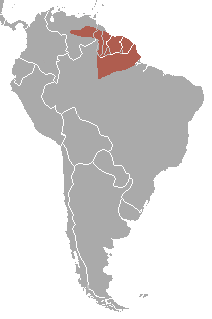Pale-throated sloth
| Pale-throated sloth | |
|---|---|
 |
|
| Diorama specimen | |
| Scientific classification | |
| Kingdom: | Animalia |
| Phylum: | Chordata |
| Class: | Mammalia |
| Superorder: | Xenarthra |
| Order: | Pilosa |
| Suborder: | Folivora |
| Family: | Bradypodidae |
| Genus: | Bradypus |
| Species: | B. tridactylus |
| Binomial name | |
|
Bradypus tridactylus Linnaeus, 1758 |
|
 |
|
| Pale-throated sloth range | |
The pale-throated sloth (Bradypus tridactylus) is a species of three-toed sloth that inhabits tropical rainforests in northern South America.
It is similar in appearance to, and often confused with, the brown-throated sloth, which has a much wider distribution. Genetic evidence has been interpreted to suggest the two species diverged only around 400,000 years ago, although the most recent evidence indicates the split was closer to 6 million years.
Pale-throated sloths have a rounded head with a blunt nose and small external ears. The limbs are long and weak, with the arms being nearly twice the length of the hindlimbs. The hands and feet each have three digits, armed with long, arched claws, with the middle claw being the largest and most powerful. Males are 45 to 55 centimetres (18 to 22 in) in head-body length, with a short, 4 to 6 centimetres (1.6 to 2.4 in), tail, and weigh from 3.2 to 6 kilograms (7.1 to 13.2 lb). However, the females are noticeably larger, being from 50 to 75 centimetres (20 to 30 in) in length, and weighing 3.8 to 6.5 kilograms (8.4 to 14.3 lb).
The body is covered with coarse guard hairs up to 10 centimetres (3.9 in) long, with a finer undercoat. Green algae live mutualistically between the microscopic scales on the surface of the guard hairs, giving the sloth a somewhat greenish appearance that serves as camouflage. Adults are blackish-grey over most of the body, with darker patches distributed over the backs, shoulders, and hips. Males have a bright yellow or orange patch on the back, divided by a central black stripe. Pale-throated sloths are difficult to distinguish from the closely related brown-throated sloth, but, as their name implies, have a pale yellow patch on the throat.
The eyes are large and forward facing for binocular vision, with round pupils. Unusually, they appear to lack any cone cells in the retina, suggesting that the sloth is unable to see color. Despite its apparently small ears, the pale-throated sloth has excellent hearing; it has also been reported to have a good sense of smell.
...
Wikipedia

